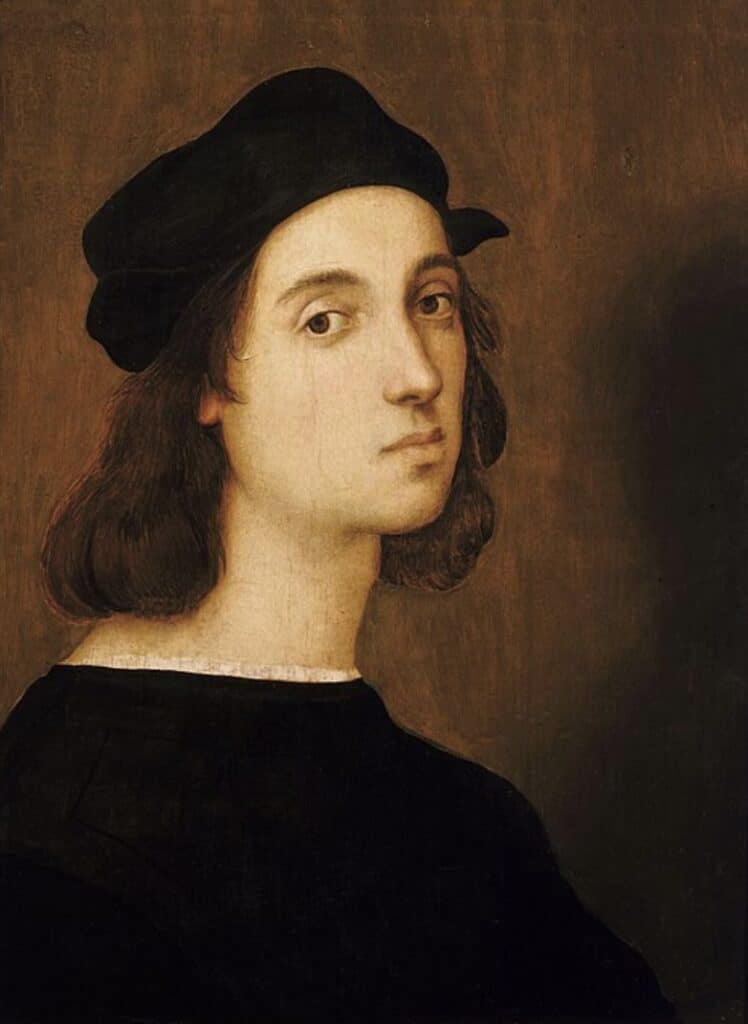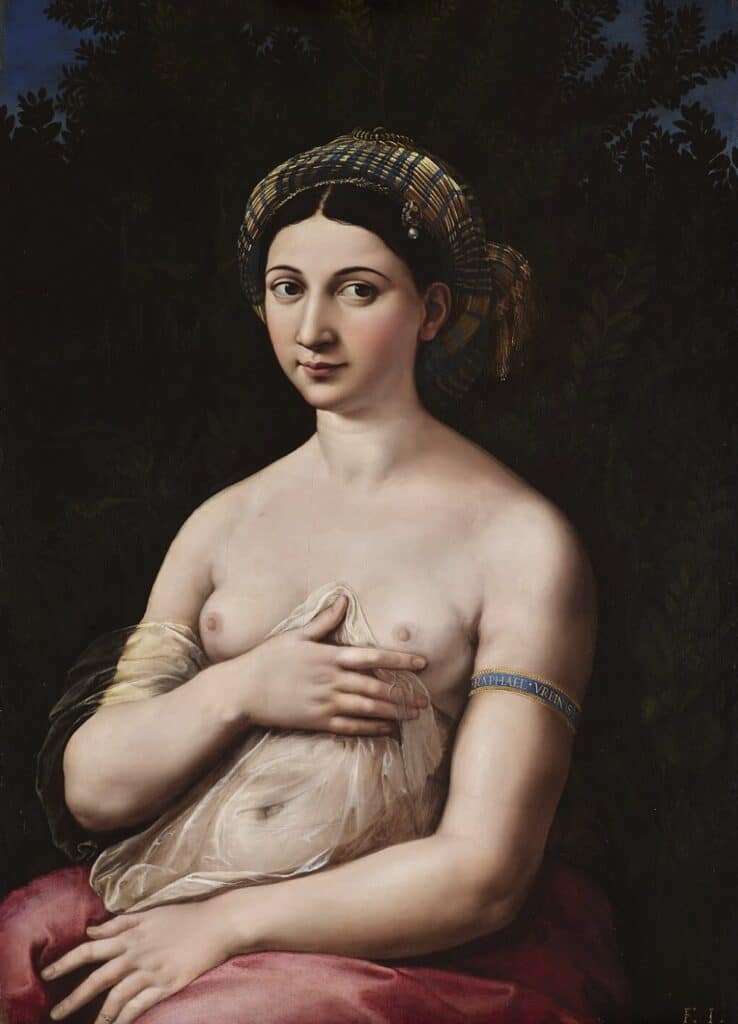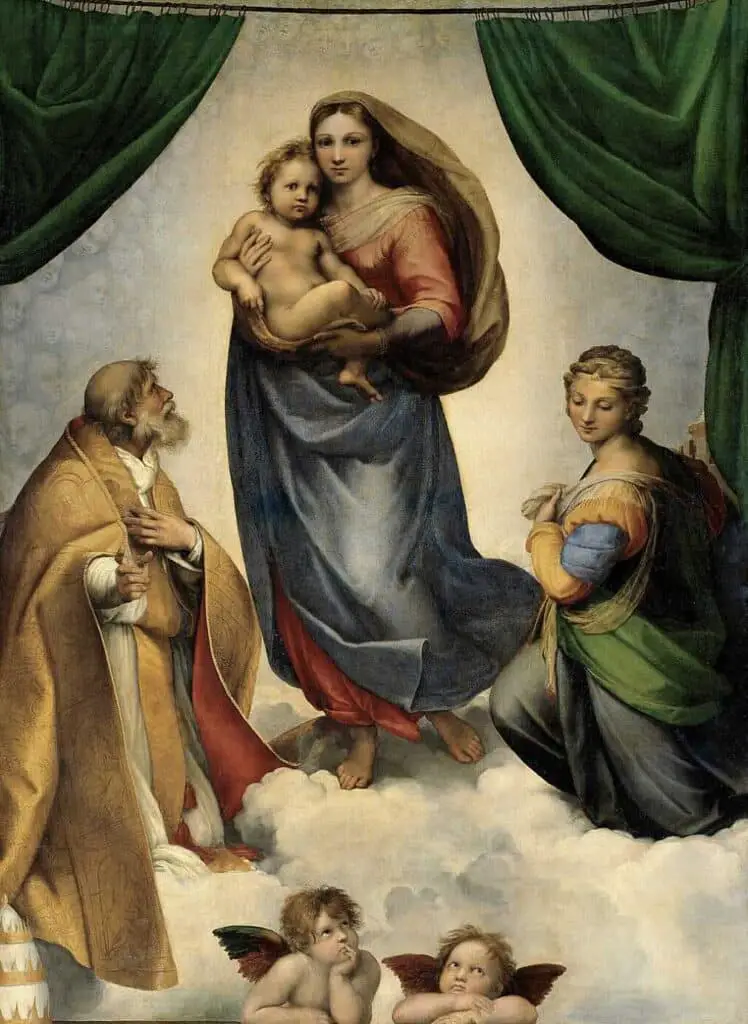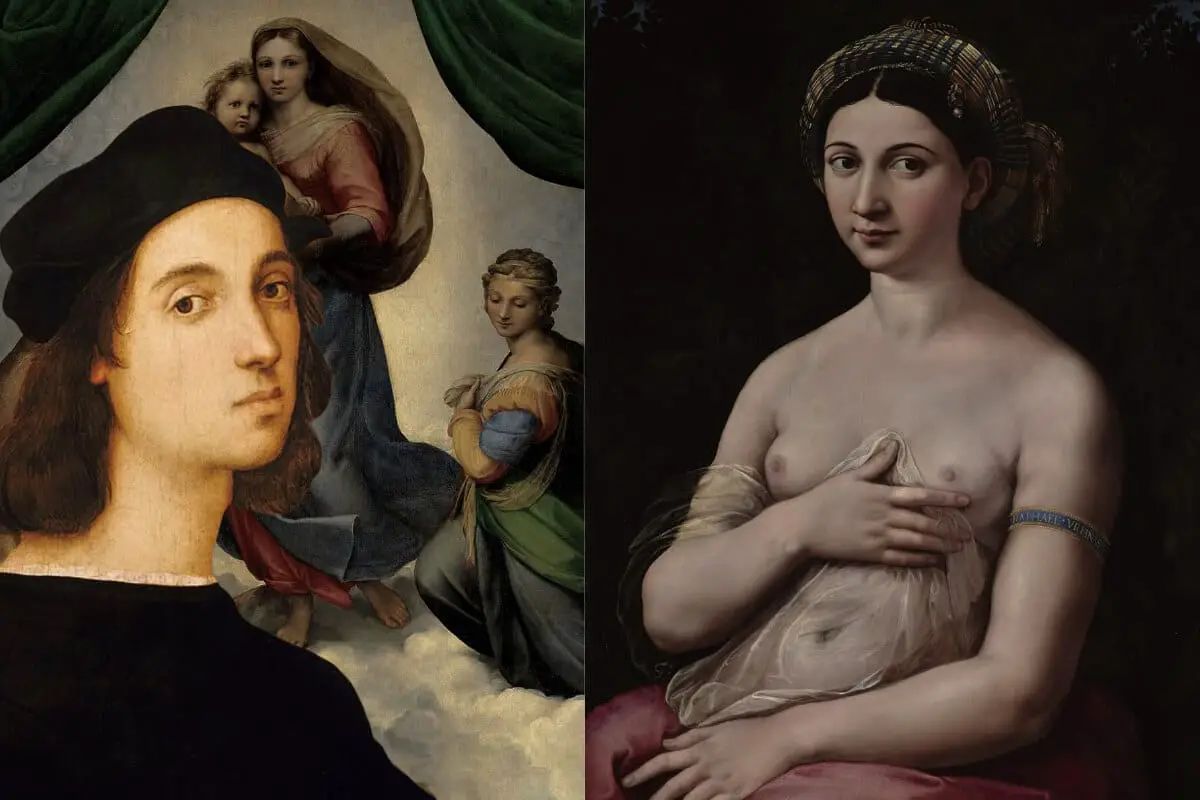Raphael’s role as a pioneering artist of the Renaissance was shaped by many factors, from his early exposure to art in Urbino to his defining contributions to the Vatican’s grandeur.
This blog explores the intricacies of his developmental years, his major works that continue to captivate audiences, and his lasting influence on art and culture. Each section of this narrative aims to bring the reader closer to the essence of Raphael’s artistry and the historical context that molded his legacy.
Table of Contents
- Raphael’s Early Life and Training
- The Vatican Frescoes: Raphael’s Magnum Opus
- Raphael and the Renaissance Woman
- Related Questions
Raphael’s Early Life and Training
Raphael’s early years played a crucial role in sculpting his path as a celebrated artist of the Renaissance. Born Raffaello Sanzio on April 6, 1483, in Urbino, Italy, his environment and upbringing nurtured his artistic flair. Urbino was a cultural hub, and Raphael’s father, Giovanni Santi, was a court painter for the Duke of Urbino.
This connection provided Raphael with an early exposure to the arts, something not many children his age had the privilege of experiencing. By observing his father’s work, he gained a foundational understanding of artistic techniques and the importance of patronage in an artist’s career.
Tragedy struck Raphael at a young age when he lost both his parents by the age of 11. However, these circumstances pushed him to take his craft more seriously instead of hindering his progress. He was placed under the guardianship of his father’s colleague, but it was clear Raphael had inherited his father’s talent and would soon surpass the capabilities of his local mentors.
Recognizing his potential, Raphael was sent to apprentice with the noted artist Pietro Perugino. Perugino’s influence on Raphael was profound, with Raphael absorbing his master’s finesse for detail and depth, which were signatures of Perugino’s style. Raphael’s earliest works resemble his mentor’s compositions, showcasing a strong foundation in the traditional principles of Renaissance art.
Raphael’s move to Florence in 1504 marked a significant turn in his artistic journey. Florence was the epicenter of Renaissance creativity, brimming with the works of masters like Leonardo da Vinci and Michelangelo. Here, Raphael’s style began to evolve. He was drawn to the emotional depth and intricate portrayal of the human body in Leonardo’s works and Michelangelo’s powerful expressions and forms.
This period was crucial for Raphael as he started experimenting with his style, integrating the delicate grace learned from Perugino with the dynamic expressions and robust forms appreciated in Florence.
What set Raphael apart was his ability to learn from his surroundings and adapt. His ability to assimilate various styles and techniques into his work without losing his unique voice made his art stand out.
His time in Florence enriched his palette, making his compositions more vibrant and his characters more lifelike. This transition was evident in his Florentine Madonnas, which combined the serene beauty observed in Perugino’s works with the emotional depth characteristic of the Florentine artistic movement.
In 1508, Raphael’s burgeoning reputation as an artist led to a summons by Pope Julius II to Rome, where he was commissioned to decorate the Vatican’s rooms. This opportunity allowed Raphael to fully showcase his mature style, blending his early influences with his own innovations, leading to masterpieces that would cement his place as one of the Renaissance’s greatest artists.
Raphael’s early years, marked by personal loss, mentorship under a master artist, and exposure to the leading artistic movements of his time, shaped his journey from a talented apprentice to a master in his own right. His ability to absorb and blend the strengths of his predecessors and peers with his innate talent and vision created a body of work that remains revered for its beauty, emotional depth, and technical mastery.

The Vatican Frescoes: Raphael’s Magnum Opus
Receiving the prestigious commission from Pope Julius II to decorate the Vatican’s rooms, Raphael was given an unparalleled opportunity to cement his status in the annals of art history. This assignment wasn’t just another job but a challenge that would test his ingenuity, versatility, and mastery of the art.
What makes the Vatican Frescoes Raphael’s crowning achievement is not just the scale or the patronage but the synthesis of technical prowess, innovative narrative capacity, and the profound impact these works had on future generations of artists.
The Vatican Frescoes signify a pinnacle in Raphael’s career for several reasons. Firstly, the project’s sheer scale allowed Raphael to experiment with unprecedentedly complex compositions and intricate details. The Rooms of the Vatican, particularly the Raphael Rooms, are expansive, necessitating a level of detail and creativity that few artists of his time could have mustered. Raphael’s ability to fill this vast canvas with coherent, visually arresting narratives showcases his exceptional artistic and storytelling skills.
Secondly, these frescoes represent a moment of artistic maturity for Raphael. By the time he embarked on this magnum opus, Raphael had soaked in the influences of the greatest artists of his time, including Michelangelo and Leonardo da Vinci. However, instead of merely emulating these masters, Raphael synthesized these influences into a unique style that was entirely his own.
The frescoes demonstrate his unparalleled ability to blend Michelangelo’s grandeur and dynamism with Leonardo’s emotional depth and subtlety. This blend of influences is most evident in the School of Athens, where Raphael pays homage to his contemporaries and predecessors and asserts his narrative skill and philosophical understanding.
Moreover, the Vatican Frescoes allowed Raphael to engage directly with themes of theology, philosophy, and the human experience on a grand scale. His treatment of these subjects is not just technically accomplished but deeply humanistic, reflecting the broader intellectual currents of the Renaissance.
Through figures that are at once idealized and intensely human, Raphael bridges the divine and the earthly, bringing complex theological and philosophical ideas into the realm of the visual and, thereby, accessible to all. This ability to render the profound so palpably sets the Vatican Frescoes apart as not just works of art but as cultural artifacts that continue to speak to viewers centuries after their creation.
Finally, Raphael’s work on the Vatican Frescoes revolutionized the context of artist-patron relationships. While fulfilling the demands of his patron, Pope Julius II, Raphael also asserted his artistic vision, demonstrating that the artist was not just a craftsman but an intellectual and creative force in his own right.
This assertion laid the groundwork for future artists to seek independence in their creative pursuits, altering the dynamics of art creation and patronage.
In sum, the Vatican Frescoes stand as Raphael’s crowning achievement because they encapsulate the essence of his artistic journey. They reflect his technical mastery, his ability to synthesize and innovate upon the works of his predecessors, his deep engagement with the intellectual currents of his time, and his subtle revolution in the artist-patron relationship.
Through these frescoes, Raphael solidified his legacy and pushed the boundaries of what art could achieve, influencing countless artists and forever altering the course of art history.
Raphael and the Renaissance Woman
Raphael’s depiction of women in his artwork captivated the art world and intricately reflected the ideals of the Renaissance. This period was marked by a resurgence in the appreciation of the human form, intellect, and individuality, ideals that Raphael skillfully wove into his portrayals of women.
Unlike his contemporaries, who often depicted women in more traditional, sometimes even subjugated roles, Raphael chose to elevate the women in his paintings to realms of grace, intelligence, and moral virtue. This decision did not happen in a vacuum; it was a testament to the changing perceptions of the era, which placed a new emphasis on the depth and complexity of individuals, regardless of gender.
At the heart of Renaissance ideals was the concept of “humanism,” a philosophical stance that emphasized the value and agency of human beings. Raphael, with his acute sensitivity to the philosophical undercurrents of his time, captured this spirit in his portrayal of women.
In his paintings, women were no longer mere backgrounds or accessories; they became central figures, imbued with dignity, grace, and intellect. This was a substantial departure from medieval representations, where women were often depicted as either saintly or sinful, with little nuance in between.

In paintings like “La Fornarina,” Raphael showcases a woman who is sensuously appealing and radiating with inner strength and self-assuredness. This duality captures the Renaissance man’s aspiration to recognize the complexity of the human spirit. “La Fornarina is not just a portrayal of physical beauty but a celebration of the qualities that the Renaissance held dear—balance, harmony, and a deep appreciation for the individual.

Similarly, in “The Sistine Madonna,” Raphael elevates the portrayal of the Virgin Mary, presenting her not just as the mother of Christ but as a figure of sublime grace and majesty. Through her, Raphael communicates the deeply held Renaissance belief in the potential for human beings to embody ideal virtues.
Mary’s representation breaks away from the passive, distant depictions of earlier times, highlighting her as an active, divine presence, connecting heaven and earth. This approach not only underscores the era’s spiritual ideals but also its belief in the power and significance of the human figure.
Moreover, Raphael’s ability to blend divine and earthly qualities in his female subjects exemplified the Renaissance preoccupation with “ideal beauty.” This was not just a superficial or physical ideal but was imbued with moral and intellectual virtues. Women in his paintings are often set against backdrops that hint at the intellectual advancements of the time, be it through allegorical references or the inclusion of objects like books, emphasizing the Renaissance value placed on knowledge and education.
Raphael’s women are more than just figures; they are narratives of their own, embodying the complexities and the aspirations of the Renaissance soul. Through his art, Raphael champions the idea that physical and intellectual beauty are not mutually exclusive but an intertwined aspect of the human experience. His depiction of women mirrors the intellectual currents of his time and contributes to the shifting perceptions towards women’s roles and capabilities.
In essence, Raphael’s portrayal of women serves as a canvas reflecting the ideals of the Renaissance. Through his brush, women transcended their traditional roles, embodying the era’s pursuit of knowledge, beauty, and moral virtue.
Through his art, Raphael dialogues with his contemporaries and the generations that followed, about the infinite potential and dignity of the human spirit. This conversation remains as relevant today as it was in the flowering of the Renaissance.
Raphael’s enduring legacy as a master of the Renaissance is not just in the beauty and realism of his works but in how his innovations continue to inspire the trajectory of art history. His contributions have transcended time, influencing generations of artists and admirers alike.
This blog sheds light on the profound impact of his life, from early beginnings to his magnum opus and his depictions of women, culminating in a nuanced understanding of his multifaceted contributions to art. Raphael’s story is a testament to the lasting power of creativity, vision, and the human spirit’s capacity to manifest beauty and truth through art.
Anita Louise Art is dedicated to art education, great artists, and inspiring others to find and create their art. We love art that uplifts and inspires. #ArtToMakeYouSmile! #ArtToMakeYouHappy!
If you are interested to see any of my art, you can find out more by clicking here. If you are interested in what inspires me and my paintings, you can discover more by clicking here.
We have a free newsletter and would love you to be part of our community; you can subscribe to the newsletter by clicking here. If you have any questions, I would be happy to talk to you anytime. You can reach me, Anita, by clicking here.
Subscribe to our Anita Louise Art YouTube Channel with great videos and information by clicking here.
Join us for our podcast “5 Minutes With Art.”Spend 5 minutes a week with us to discover and learn about great art and artists. You can find out more about our podcast by clicking here.
Related Questions
Why Was Impressionism Art At First Rejected?
During the emergence of impressionism art, fine-art oil painting was an essential addition to the interior design of a home, especially for the affluent and the increasing arrival of the middle classes. For these art patrons, only some art styles were considered acceptable for them to use for the interior design of their home, and impressionism art did not fit into any of these culturally acceptable fine art categories.
By clicking here, you can learn more by reading Why Was Impressionism Art at First Rejected?.
Why Is Van Gogh Considered Such A Great Artist?
Many things make Vincent Van Gogh unique and great as an artist. He had a great way to use color in his art, but more than that, he was an artist who set and paved the way for other artists. He changed art with his brushstroke technique, how he used color, and his design abilities. Van Gogh did all this as a self-taught artist.
By clicking here, you can learn more by reading Why Is Van Gogh Considered Such A Great Artist?.
What Art Tools Did Vincent Van Gogh Use?
Vincent Van Gogh used most of the essential tools that artists of his day used, such as oil paints, turpentine, oil, canvas, brushes, palette knife, and easel. We learn from some of his letters how he used these art tools for his paintings. We also know from the letters how essential these art tools were to him.
By clicking here, you can learn more by reading What Art Tools Did Vincent Van Gogh Use?.

